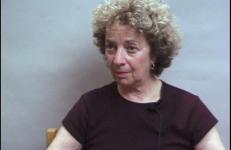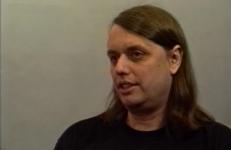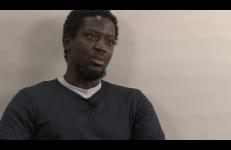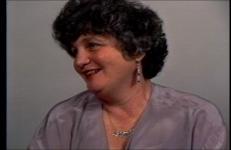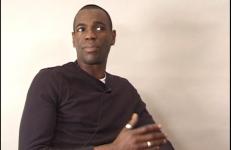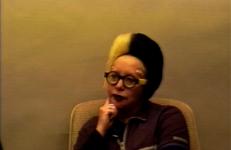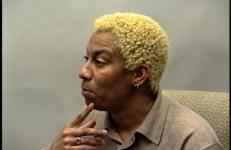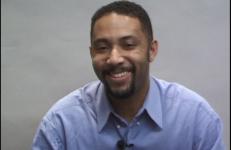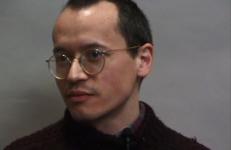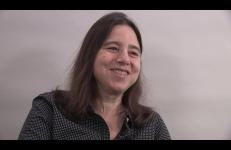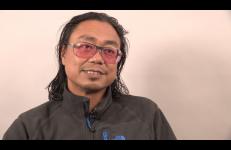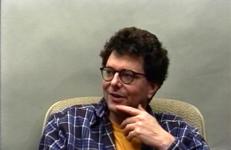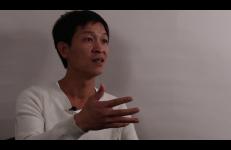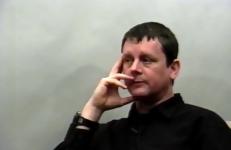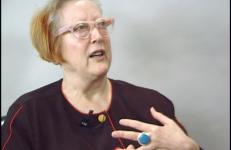In this interview, Phyllis Kornfeld, author of Cellblock Visions: Prison Art in America, describes her initial interest in working with prisoners in her native Oklahoma City, stemmed from an exploration of outsider artists. Detailing her first visit to a high security prison as a ‘mind blowing and breathtaking’ experience, Kornfeld discusses how she came to her realization that prisons are fertile environments for free form experimentation with the teaching process. She learned that through personalized art education, inmates could teach themselves to make positive contributions to society. - Kyle Riley
Visiting Artists Program
Steve Kurtz is a founding member of the Critical Art Ensemble and Associate Professor of Art at University of Buffalo. His areas of focus are contemporary art history and theory as well as post-studio practices. As a student Kurtz collaborated with Steve Barnes on low-tech videos, which they developed into a broad-based artist and activist collective known as the Critical Art Ensemble.
Interview by Gregg Bordowitz.
A historical interview originally recorded in 1999 and re-edited in 2005.
Sharon Lockhart is a photographer and filmmaker. Her photographic and filmic works interrogate the inversion of the static image as cinematic and the manipulation of the moving image into a static/stop-motion frame. Her work also contemplates how we perceive our own real-time realities.
Born in 1987, Ibrahim Mahama is an artist and author who creates monumental installations out of materials originating from Ghana, Mahama's home. Described in The Guardian as "a junkyard utopian", he investigates the conditions of supply and demand in African markets, often making work with materials like cocoa and jute sacks.
In 1973 Joan Nestle co-founded the Lesbian Herstory Archives, an essential collection of documents, writings, and artifacts of lesbian cultural history. In 1979 she began writing erotic stories and has published two collections of writings: A Restricted Country (1987) and A Fragile Union (1998). She took a controversial stance in opposition to the 1980s feminist anti-pornography movement, thus becoming a fervent pro-sex activist in the “Sex Wars.” Interview by Nina Levitt.
In this interview, Kori Newkirk (b.1970) describes his interest in the space that exists between categories. Hailing from the Bronx, earning a BFA at the School of the Art Institute of Chicago (SAIC), and finally settling on Los Angeles as his base of operations, Newkirk has always been motivated by a desire to eschew provincialism. In this conversation, he discusses the idea of regional identity, his complex relationship with the Los Angeles art community, and how his experience as a student at SAIC helped him move beyond the boundaries of a simple material definition of painting.
French performance artist Orlan uses her own body as a sculptural medium. Since 1990, she has worked on La Reincarnation de Sainte-Orlan, a process of plastic surgeries that she “performs,” making elaborate spectacles with surgeons dressed in sci-fi costumes and broadcasting the operations live via satellite to galleries worldwide. By exploring a total transformation of self, Orlan delves into issues of identity and the malleability of the flesh. She lives and works in Paris, exhibiting and performing internationally.
Interview by Shay Degrandis, via translator.
Ingrid Pollard is a photographer living in London. Her photographic works, generally of people and landscape, serve to provide a human context for issues of transmigration and “fleeting” identity. Combining personal photographs with traditional views of the English countryside, Pollard questions as well as reconstructs the concept of “Britishness.” In doing so, Pollard also scrutinizes the location of the “other,” and contrasts actual physical similarity or material likeness of people and places with perceived or socially constructed difference.
Tom Poole is an organizer of many things. Counting arts administrator, media facilitator, and activist among the many titles he has held over the years, Poole currently brings all these capacities to bear as the executive director of the Pittsburgh Community Television (PCTV) station. In his contribution to the On Art and Artists series, Poole discusses his early foray into media activism as a member of the video art collective Black Planet Productions.
Joe Sacco is a cartoonist who has contributed to a wide range of comic magazines including Drawn and Quarterly, Prime Cuts, Real Stuff, Buzzard, and R. Crumb’s Weirdo; he continues to illustrate the semi-regular Painfully Portland cartoon strip for the Willamette Week. He was a recipient of the prestigious American Book Award in 1996 for his work Palestine (1996), which combines techniques of eyewitness reportage with comic strip storytelling.
This interview depicts American writer, activist, and AIDS historian Sarah Schulman (b. 1958), discussing becoming a writer, her novels, and her long-term collaboration with filmmaker James Hubbard on projects devoted to gay liberation and AIDS activism. Born in New York to a Holocaust-surviving family, Schulman grew up in an era where women were not considered important.
At the age of twenty-four, Taiwanese artist Tehching Hsieh (b.1950), moved to New York, where he has created and documented time-specific, conceptual art performances since the 1970s. In this interview, Hsieh discusses his formative years and philosophical moorings. This dialogue includes description of the artist’s early period of painting, his military service in Taiwan, and the cultural atmosphere of a country then undergoing massive political change. Much of the discussion focuses specifically on Hsieh’s understanding of the relationship of art and life, his investment in “free thinking,” and the politics of documentation. For Hsieh, the ability to think freely is art’s bottom line—he believes the essence of his work lies in human communication. To this end, Hsieh insists that his work, though incredibly personal, is not autobiographical, but philosophical.
Rirkrit Tiravanija’s work explores the social role of the artist, and that role’s ability to create interactive spaces for people to come together. Focusing less on the construction of discrete objects, he maintains a practice predicated on diffuse forms of installation that facilitate the activities like cooking, reading, and general collectivity. The particularly conceptual nature of his work is a central theme in this interview. While in art school, a teacher Tiravanija greatly admired told him to “stop making art” and this was something he took very seriously.
Fred Tomaselli’s mosaics and collages compose patterns and images that suggest ancient global influences. His materials, however, are products of modern consumption, addiction, bodily abuse, and pleasure: pills, nicotine patches, bandages, and the like. The surfaces are coated with a lacquered veneer, making these mundane sources of highs or healing gleam. Interview by James Rondeau. A historical interview originally recorded in 1999 and re-edited in 2007.
In this interview, Los Angeles-based artist and filmmaker Ryan Trecartin (b. 1981) discusses his personal interests and motivations, as well as the larger cultural and philosophical concerns that shape his videos and their reception. Trecartin is known for his construction of non-linear narratives, campy costumes, and excessively visceral characters and environments. One of the most compelling aspects of this interview is his insistence that language and its verbal articulation, rather than the visual, anchor his process. Trecartin identifies the influences of 1990s retro-rave culture, hip-hop videos, and editing software tools on his work. He notes that the accelerated disintegration of high and low culture has played a major part in his growth as an artist.
Danh Vo is a Vietnamese-born Danish conceptual artist, currently living and working between Berlin and Mexico City. His large installations often deal with issues of personal identity and belonging. In conversation with Norah Taylor, an art historian specializing in South and Southeast Asian art, Vo discusses his upbringing, career, and what led him to become an artist.
Although trained as an art historian, Jeff Wall has been working on his expansive photographic light boxes of staged scenes for more than 25 years. Using back-lit, photographic transparencies typically used for advertising display, Wall subverts their commercial association by filling them with quotidian objects.
Eyal Weizman is a British-Israeli architect and academic. He’s the founder of Forensic Architecture, which uses architectural research to investigate violations of human rights around the world. In this interview, Weizman discusses his career and the importance of Forensic Architecture’s work with Jonathan Solomon, Director of the Department of Architecture, Interior Architecture, and Designed Objects at the School of the Art Institute of Chicago.
David Wilson is the founder and curator of the Museum of Jurassic Technology in Los Angeles. His collection of found and contributed objects provides an astonishing array of materials derived from craft and nature. Interview by Rachel Weiss. A historical interview originally recorded in 1998.
Feminist performance artist, Martha Wilson (b.1947), is director and founder of the alternative New York art space, Franklin Furnace Gallery, in operation since 1976. In this interview, Wilson discusses her Quaker upbringing, the impetus for her move from Nova Scotia to New York, and the founding of Franklin Furnace, as well as her involvement in the feminist punk band collective Disband.




